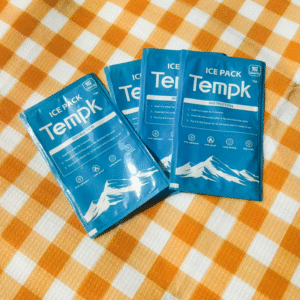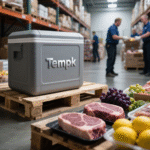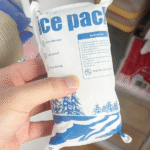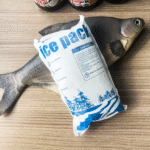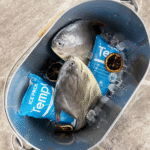Cuando se trata de envío de cadena fría, Seleccionar el método de enfriamiento correcto es fundamental para garantizar que sus productos sensibles a la temperatura lleguen a su destino en condiciones óptimas. Si está enviando productos farmacéuticos, alimento, o muestras biológicas, La elección correcta entre hielo seco y paquetes de gel puede marcar la diferencia. En esta guía, Exploraremos los beneficios únicos, aplicaciones, e impactos ambientales de hielo seco y paquetes de gel para ayudarlo a tomar la decisión más informada.
Diferencias clave entre Paquetes secos de hielo y gel
-
Rango de temperatura: El hielo seco ofrece enfriamiento extremo (-78.5°C / -109.3°F), Mientras que los paquetes de gel son mejores para un enfriamiento moderado (0-10°C / 32-50°F).
-
Duración del enfriamiento: El hielo seco dura más, haciéndolo ideal para envíos de larga distancia, Mientras que los paquetes de gel son más adecuados para viajes más cortos.
-
Costo: El hielo seco tiende a ser más caro, mientras que los paquetes de gel son más asequibles y reutilizables.
-
Impacto ambiental: Secro Ice libera gas CO2 pero no deja residuos, Mientras que los paquetes de gel son reutilizables y están hechos con más materiales ecológicos.
Que es el hielo seco?
hielo seco, la forma sólida de dióxido de carbono (Co₂), es reconocido por sus capacidades de enfriamiento extremas. Mantiene una temperatura de aproximadamente -78.5 ° C (-109.3°F), haciéndolo perfecto para productos que necesitan permanecer congelados durante los viajes largos.
Beneficios del hielo seco:
-
Temperaturas extremadamente bajas: Ideal para bienes congelados como productos farmacéuticos, muestras biológicas, y alimentos perecederos.
-
Sin residuos líquidos: Previene el daño relacionado con la humedad, Un problema común con el hielo regular.
-
Enfriamiento a largo plazo: Adecuado para envíos sobre duraciones extendidas, incluyendo envíos internacionales.
Aplicaciones comunes:
-
Productos farmacéuticos: Preservar vacunas, biológicos, y otros materiales sensibles.
-
Transporte de alimentos: Asegurar los alimentos congelados como el helado, carnes congeladas, y los mariscos permanecen congelados.
¿Qué son los paquetes de gel??
paquetes de gel son bolsas flexibles llenas de gel no tóxico que se congela a temperaturas superiores a 0 ° C (32°F). Mientras no alcanzan las bajas temperaturas de hielo seco, Ofrecen un enfriamiento efectivo para productos que necesitan mantenerse refrigerados pero no congelados..
Beneficios de los paquetes de gel:
-
Reutilizabilidad: Se puede refrozarse y usarse varias veces, haciéndolos una opción rentable y sostenible.
-
Facilidad de manejo: Los paquetes de gel no son tóxicos, No requiere un manejo especial, y son seguros para la mayoría de los tipos de productos.
-
Versátil: Adecuado para una amplia gama de productos, Desde productos farmacéuticos hasta alimentos perecederos.
Aplicaciones comunes:
-
Cosméticos y cuidado personal: Mantener temperaturas estables para productos como el cuidado de la piel y los cosméticos.
-
Productos frescos y lácteos: Envío de frutas frescas, verduras, y productos lácteos que necesitan mantenerse frescos pero no congelados.
Paquetes de hielo seco vs gel: ¿Cuál deberías elegir??
Cuándo usar hielo seco:
-
Bienes congelados: Para envíos que necesitan permanecer por debajo de la congelación, como alimentos congelados y vacunas.
-
Largos tiempos de tránsito: Cuando se extiende la duración del envío, El hielo seco asegura que los productos permanezcan congelados durante largos períodos.
-
No se desea residuo líquido: Si prevenir el daño por humedad es crucial, El hielo seco es la mejor opción.
Cuándo usar paquetes de gel:
-
Artículos fríos: Para artículos que solo necesitan mantenerse frescos, como productos frescos o cosméticos.
-
Tiempos de tránsito cortos: Si la duración del envío es corta, Los paquetes de gel proporcionan una solución de enfriamiento efectiva sin la necesidad de temperaturas extremas.
-
Sostenibilidad: Los paquetes de gel son más ecológicos y reutilizables, haciéndolos ideales para empresas que buscan reducir su impacto ambiental.
Consideraciones de costos: Que es más asequible?
Mientras hielo seco es más caro debido a su mayor eficiencia de enfriamiento y requisitos de manejo especiales, paquetes de gel ofrecer una solución más económica. Son reutilizables, reduciendo el costo por envío, Especialmente para empresas con necesidades de envío regulares.
| Aspecto | Hielo seco | Paquetes de gel | Beneficios prácticos |
|---|---|---|---|
| Rango de temperatura | Por debajo de -78.5 ° C (-109.3°F) | 0°C a 10°C (32° F a 50 ° F) | Hielo seco para congelar, paquetes de gel para enfriamiento moderado |
| Manejo de complejidad | Requiere un manejo especial | Fácil de manejar, Sin precauciones especiales | Los paquetes de gel son fáciles de usar |
| Costo | Más alto | Más bajo | Los paquetes de gel ofrecen soluciones más asequibles |
| Reutilizabilidad | De un solo uso | Reutilizable | Los paquetes de gel ofrecen ahorros a largo plazo |
| Impacto ambiental | Emisiones de CO2 de sublimación | Más ecológico | Los paquetes de gel son reutilizables y ambientalmente sostenibles |
Impacto ambiental: ¿Qué opción es mejor para el planeta??
hielo seco libera el gas de co₂ a la atmósfera, contribuyendo a las emisiones de gases de efecto invernadero. Sin embargo, Su residuo mínimo y su capacidad de enfriamiento de larga duración lo convierten en una opción preferida para envíos que requieren frío extremo.
paquetes de gel, por otro lado, son reutilizables y están hechos de materiales más sostenibles. Tienen una huella ambiental más pequeña, especialmente cuando se usa varias veces. Las innovaciones en materiales de paquete de gel biodegradable mejoran aún más su sostenibilidad ambiental.
Combinando paquetes de hielo seco y gel para envío óptimo de la cadena de frío
En algunos casos, Puede ser beneficioso usar paquetes de hielo seco y gel.. Esta combinación puede proporcionar frío extremo para productos específicos mientras enfriamiento moderado para otros, Permitir una solución más equilibrada y rentable.
2025 Tendencias en el envío de la cadena de frío: Paquetes de hielo seco vs gel
La industria del transporte marítimo de la cadena fría continúa evolucionando en respuesta al aumento de las demandas de soluciones sostenibles y eficientes.. En 2025, Esperamos:
-
Embalaje inteligente: Los sistemas de monitoreo de temperatura ayudan a las empresas a rastrear sus envíos en tiempo real, Asegurar que los bienes permanezcan dentro de los rangos de temperatura requeridos.
-
Materiales ecológicos: Los avances en materiales de paquete de gel biodegradable los harán aún más amigables con el medio ambiente.
-
Envío de eficiencia energética: Las soluciones de envío con energía solar ganarán tracción, Reducción de la huella de carbono de la logística de la cadena de frío.
Preguntas frecuentes
Q1: ¿Puedo usar hielo seco para el envío de alimentos congelados??
Sí, El hielo seco es ideal para el envío de alimentos congelados, ya que mantiene temperaturas extremadamente bajas necesarias para mantener los alimentos congelados durante las largas duraciones de envío.
Q2: ¿Son reutilizables los paquetes de gel??
Sí, Los paquetes de gel se pueden volver a reiniciar y reutilizarse varias veces, haciéndolos una opción sostenible y rentable para el envío de la cadena de frío.
Conclusión: Tomar la decisión correcta para sus necesidades de envío en cadena de frío
Al elegir entre hielo seco y paquetes de gel, La mejor solución depende de los requisitos de temperatura de su envío, duración, Consideraciones de costos, e impacto ambiental. El hielo seco es ideal para productos congelados y envíos de larga distancia, Mientras que los paquetes de gel son mejores para productos fríos y viajes más cortos. Evaluando cuidadosamente sus necesidades específicas, Puede seleccionar la solución más efectiva y rentable para su logística de la cadena de frío..
Acerca de Tempk
En Templ, Nos especializamos en proporcionar soluciones innovadoras de empaque de cadena de frío diseñadas para garantizar el transporte seguro y eficiente de los productos sensibles a la temperatura.. Si está enviando productos farmacéuticos, alimento, o perecederos, Ofrecemos soluciones a medida para satisfacer sus necesidades.
Contáctenos hoy para soluciones personalizadas de cadena de frío!






